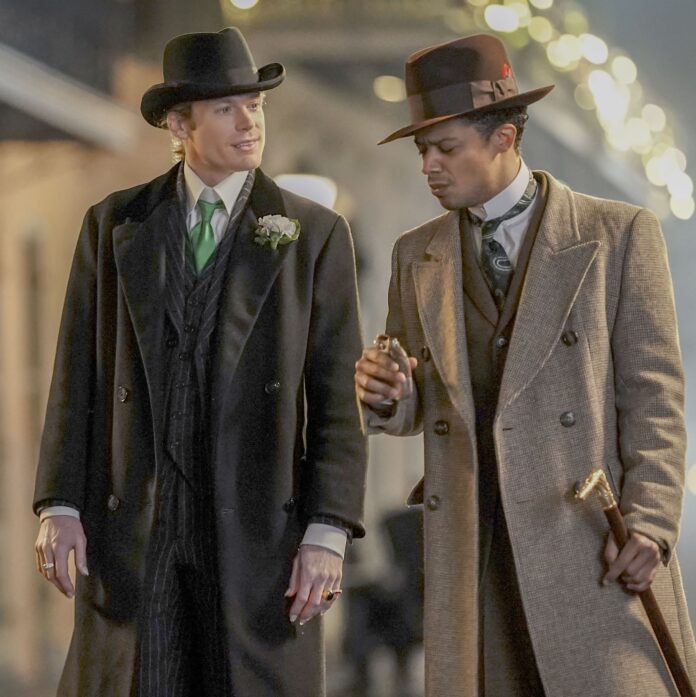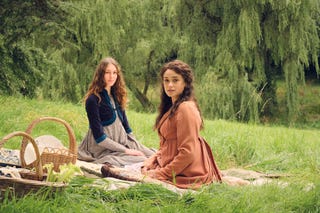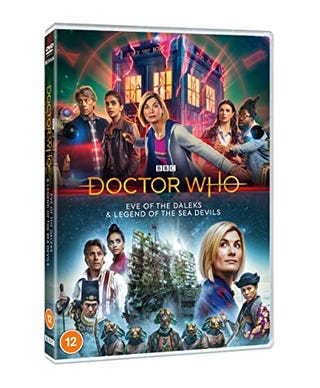Interview with the Vampire episode 1 spoilers follow.
Vampires are gay. They’re super gay, in fact, and they always have been, so don’t let Twilight convince you otherwise.
As far back as 1819, writer John Polidori wrote a short story called The Vampyre, which revolved around his fascination with Lord Byron. Since then, other vampire writers have repeatedly done their utmost to gay things up and continue that legacy.
For that, we are eternally grateful. But like the bloodsuckers themselves, homoerotic themes within these stories have long been forced to hide in the shadows, lurking in the subtext.
There are exceptions of course. What We Do In The Shadows shines a queer light on said shadows, and First Kill also pulled hot sexy gay vampires to the fore prior to its (homophobic) cancellation. And then, of course, there’s True Blood, which made Fangbangers out of us all back in the late noughties.
But by and large, hot sexy gay vampires have been neutered onscreen, drained of their passion and flair like a delicious human who’s just stumbled into the wrong alley at night.
Enter Interview with the Vampire, AMC’s adventurous new take on the iconic Anne Rice novel.
Tom Cruise and Brad Pitt’s camp adaptation from the ’90s was pretty gay in its own way. Beautiful people and homoerotic bloodsucking went hand-in-hand throughout that movie, but SNL’s criticism at the time sums up our issue with it best: “Not gay enough!”
To be fair, the ’90s were a different era. Hollywood wasn’t exactly forthcoming when it came to hot sexy gay vampires, or even hot sexy gay humans for that matter. And that’s why Anne Rice even considered rewriting Louis as a woman when she first started working on the screenplay.
Both younger me and Brad Pitt’s manager will be forever grateful that didn’t happen, but at the end of the day, 1994’s Interview with the Vampire is still lacking when it comes to the book’s queer eroticism.
Thankfully, no one can accuse AMC’s new adaptation of not being gay enough. In a long overdue move, this new series leaps forward over a century to 1910, and its progressive take on queerness jumps forward right along with it.
The sensual pleasure and lustful gazes that define Rice’s book are all still present, but this time around, the characters actually act on their desires by making the gay subtext explicit in more ways than one.
It all starts when Louis (Jacob Anderson), a gay Black resident of New Orleans, plays poker against a rather enigmatic stranger who has everyone spellbound. Lestat (Sam Reid) is charming all of the players at once, but especially Louis, and not just because of that fancy French accent.
A friendship ensues, but both men develop an ulterior attraction. Louis is clearly drawn to Lestat with a barely suppressed longing, while Lestat is likewise infatuated with Louis, but in a far more predatory (yet no less carnal) fashion.
All this simmering tension eventually leads them both to Lestat’s house where a woman named Lily is waiting for them. The trio undress as Louis starts making out with Lily. Lestat hungrily looks on, pulling his clothes off, but when he tries to join in, Louis rejects him.
Even behind closed doors, the homophobia that Louis has faced all his life is still there, shaming him from within. Because clearly, his fixation on Lily isn’t really about Lily at all.
Sensing all this, Lestat hypnotises Lily into unconsciousness, leaving them essentially alone together, sweaty and naked. It’s only then that Louis finally gives in, lunging at Lestat with an almost vampiric intensity of his own, pre-transformation.
The kissing quickly escalates with Lestat necking Louis from behind, first without teeth, and then with teeth. Louis doesn’t care about that though. In fact, he revels in it, and so, for the first time ever, Anne Rice fans get to see one of these homoerotic feedings as something that’s explicitly queer onscreen.
It’s a stunning moment, especially when the pair levitate off the ground, all while Lestat goes in deep on Louis (likely in more ways than one). The camera takes its time here with one long, decadent shot that luxuriates in the sight of their naked bodies pressed up close, writhing in the air as they — sorry, we need a moment.
During a chat with Decider, Sam Reid (Lestat) revealed that he was particularly proud of this scene, explaining that: “It just goes to show the intensity of their connection. That was translated really beautifully.”
The term “beautiful” is key here. Because yes, this scene is shot with an exquisite tenderness, one that thankfully takes both the source material and queer love in general seriously. But beyond the camera framing and all the hot sexy gay vampires, there’s also something beautiful about the way their relationship develops too.
Now, don’t get us wrong. There are some extremely toxic power dynamics at play here, and we’re not condoning any of that. But Lestat is a vampire, after all, and so is Louis as well by the end of the episode.
With these monsters at its heart, Interview with the Vampire was never going to be an aspirational relationship guide, but what it does do well is establish a genuine, romantic love between the pair as a bona fide gay couple.
Tom Cruise and Brad Pitt could never.
It’s said that “The course of true love never did run smooth,” but the blood sure does at the end of this episode when Lestat finally drains Louis enough to transform him from a hot sexy gay man into a hot sexy gay vampire.
Afterwards, they both lay on the altar steps together, their energy spent as they recover from what the episode title rightly describes as “throes of increasing wonder”. And after that, when the credits start to roll, it’s safe to say that most of us were left reeling with those same “throes” too.
It’s not just the visibility that matters here though. That’s hugely important, of course, especially for a genre that’s flirted with these themes for so very long. But it’s in the dangerous, seductive nature of their queerness that the true impact of Interview with the Vampire can be felt.
Chatting to Esquire, Jacob Anderson AKA Louis explains how “those moments of joy and excitement and romance” are needed so “it’s not all about tortured Catholic guilt.”
“We’ve seen vampire stories told that way before,” Jacob adds. And he’s right.
For better or worse, a lot of queer media strives to only represent the best of the LGBTQ+ community. That’s understandable given how long we’ve been othered and unfairly portrayed as monstrous. But equally, there’s something appealing about that monstrous, dangerous, element too, at least when it comes to imaginary vampire trysts like this.
Monsters are to be feared, they fight to survive, and that can be empowering for people long used to being treated like monsters themselves. It’s one of the main reasons why horror appeals so much to queer audiences in the first place.
By romanticising vampires so explicitly in this show, particularly with such a strong queer underpinning, it gives permission for us to feel dangerous and strong and seductive within a safe environment onscreen.
Here, the pain and trauma isn’t rooted in the characters’ queer identity. Instead, the struggles Louis and Lestat face are of a tortured, romantic kind, the kind that straight people have long fought in public and queer people have long fought in private, whether it be in the shadows or deep in the subtext of stories like this.
Because there always have been queer stories. They just weren’t told out in the open. But now, intrinsically queer ideas, like hot sexy gay vampires, for example, have finally clawed their way into the light where they’ve always belonged. Except Twilight. No one needs to see that.
Interview with the Vampire airs weekly every Sunday on AMC in the US. A UK broadcaster and release date has not been announced yet.

























